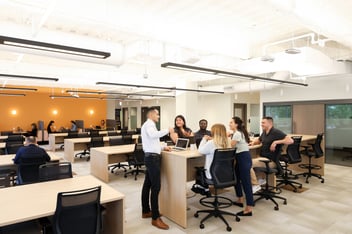The Metaphors of Coworking

I’ve been a member of a coworking space for a few years, and have served them in answering a number of questions across models for growth, industry trends, underlying changing demographics, and the ongoing redefinition of our relationship with work. Coworking, it seems, can be seen either as an incremental opportunity on top of the current trends towards more efficient use of office space and flexible working arrangements, or as the catalyst for a much broader movement in fundamentally redefining our relationship with work.
Coworking is not for everyone. It is generally seen either as place for solopreneurs, startups, small businesses, or remote teams that are part of larger organizations. Large organization will likely retain their spaces, and certain industries will likely never be a good fit (don’t expect your doctor to see you at a coworking space — for now). Frankly, we haven’t also seen the limits of what these spaces can support as we are just starting to see the range of business models that can apply. Today, there are multiple models that exist, ranging from one-off locations, to large multi-national networks (Regus, WeWork), and going through specialized industry/functional spaces. Additionally, we’re also seeing models develop that are more virtual in nature.
Describing this industry to people who do not know it is often a challenge as we often get caught in stereotypes about the industry (“Oh, it’s where startups are!”, “Oh, it’s all open floor plans!”). These fail to truly capture the richness of these spaces. That being said, I find that whenever I have such conversations, we end up using metaphors to describe coworking. Over the course of the last year, I’ve seen four metaphors consistently emerge.
Coworking as gym membership
This metaphor is most often used when discussing the pricing and revenue models of coworking spaces. Financially speaking, there are two primary drivers in making coworking spaces work: efficient use of space (keeping costs low), and revenue from membership. The revenue from membership is broken out into many sub-categories, but generally coworking spaces focus on providing a membership as a means to access the space, as opposed to a pay-per-use model. There are many reasons why this makes sense (shape & access to the community, special events, discounts & perks, etc…). However, unlike a coffee-shop where you generally pay for use of the space through your purchase, coworking is based on paying for the possibility that you will need the space. Generally, that access is not fully utilized. This is similar to a gym membership, where 67% of memberships go on never being used (Source: statisticbrain.com). While I don’t believe memberships in coworking go unused at the same rate as as gym membership (the fundamentals are different), they do go underused. In the strictest sense, if you buy a membership that gives you access for every day of the month, and you do not go for 2 business days, you end up underusing.
When coworking spaces start to think about their revenue model, they often factor some sort of oversubscription, and as such it’s not unusual (or rather a pretty good idea) to see space utilization numbers for revenue purposes in excess to 100%. Mind-you, there’s nothing inherently wrong with that, it’s just how the industry needs to be shaped.
Coworking as retail bank network
Switching to how members see coworking, and focusing our attention to those members who tend to be more mobile or geographically spread out for their work (i.e. traveling sales, consultants, distributed teams, etc…). This is a fairly large group of professionals (~20MM professionals or about ~21% of the US workforce — very rough estimate based on a few different data points), and realistically a smaller fraction of them are the most mobile segment. From conversations that I’ve had with past and present members of different spaces, I consistently hear that a primary driver for selecting a certain space is either the physical convenience, or the network convenience (and sometimes both). In other words, users want coworking spaces to be “where” they are, wherever that “where” is.
This reminds me a lot of how retail bank networks have historically developed. For the better part of the 20th century, and even into the 21st, retail bank networks have been about expanding footprints to create a sense of physical convenience for their customers, and to deepen/strengthen the relationship with customers. Thus, coworking spaces need to think about convenience for their members the same way that retail banks have historically thought about creating a network of locations.
It is not lost on me that there is an issue with using branch networks as a metaphor. Branches and branch networks have, in the last 10 or so years, started to go through a digital transformation to support the changing needs and behaviors of their customers. However, I don’t believe this applies in the same manner to coworking spaces and coworking networks. For one thing, having a physical space to do work is still a core function of how we work, at least for now.
Coworking as hospitality
Hotels provide concierge and front desk service to their guests. The combination of those two services, in theory, provides guests with a tailored experience and helps address any questions and concerns. In coworking, spaces have space managers and community managers (and often those are the same person). These people are often the anchors of the community since they shape the experience, create a program of activities, and generally work to ensure each member’s experience is tailored to their needs. As such, coworking is very much like the hospitality business.
Coworking as “not following Starbucks”
Along with convenience, community is one of the most mentioned reason why people join and stay with a coworking space. Most coworking spaces will highlight this on their websites and brochures. Sometimes, members will like the community so much that they will remain connected with the community after they leave the coworking space. Alex Hillman of Indy Hall talks about the “First 10”, the first 10 members that shape your community, and how important it is to find and cultivate them.
However, as coworking spaces look to grow, either by growing to larger formats or more locations, they are faced with the same challenge that Starbucks faced as it grew from a few locations in Seattle to the global coffee chain that it is today. This is not Starbucks’ unique challenge and dilemma. How many times have you heard “Oh, they were so much better when they were a one-location place,” or “They’ve lost their identity now that they are so much bigger” about a local store that scaled significantly. The issue is that as a place starts to scale, the quality of the experience gets lost. More often than not the space gets too large and more impersonal, or the processes put in place to scale focus on standardization of the experience rather than catering to individual needs.
For coworking spaces community is critical to success. There are too many competing offerings on the table, whether it be your living room, favorite coffee shop, local library, or the increasing number of other coworking spaces. Losing community could be the death knell of a space, and so the question becomes how to scale without going through the growth curve and challenges that Starbucks did?
How these metaphors work together
It’s a very interesting time in the coworking industry. 2015 has been marked by a steady growth of spaces across the globe, a transformation of valuations away from real estate multiples and into tech multiples, and even some spaces closing to focus on community over managing physical spaces. We’ve also seen the introduction of new-to-coworking business models like Breather and LiquidSpace. For those seeking to continue to grow through a physical footprint or those outside the space seeking to understand the opportunity, the challenge is becoming about how to work across those four metaphors. In other words, you need to build and scale a community but not lose the identity of that community (not following Starbucks); you need to provide a tailored and customized experience for all your members (Hospitality); you need to create convenience in the relationship that you establish with your members and community (retail banking network) ; and you need to ensure that you create an economically sustainable model for growth (gym membership).
About the Author: Nadir Ait-Laoussine is Founder @ Nomadic Foundry, co-founder @ Urban Mobile Sensors. Occasional dabbler in chocolate making. More info: nadirait.com / nomadicfoundry.com
About Workbar:
Workbar operates coworking locations throughout greater Boston (Boston Back Bay, Boston South Station, Burlington, Cambridge, Arlington, Brighton, Danvers, Norwood, Salem) and several other partner locations throughout the state. Want to keep up with the world of Workbar? Subscribe to our mailing list for the most up-to-date information about our upcoming events and community news. You can also follow us on Instagram, Facebook, LinkedIn and Twitter.


